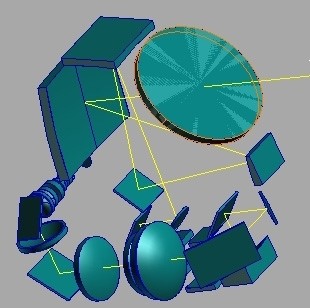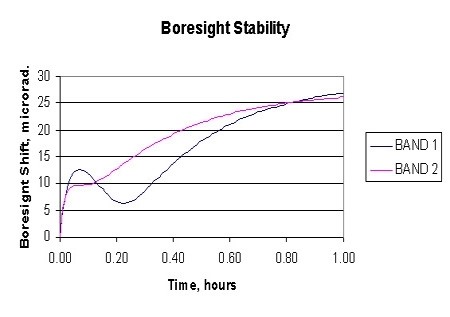Colleagues:
My Heavens! Off axis systems are everywhere. Are we having fun yet?
They pose extraordinary challenges to the optomechanical engineer. With their diverse types of elements (reflective, diffractive, refractive), wide transmission bands (UV to far IR) and multiple focal plane arrays it almost seems perverse to complain that there is insufficient room for the metering structures (you know, optical benches and that kind of stuff). In one recent job (34 optical elements and three image planes) the optical bench was just superb, but the inner gimbal ring was so flimsy that it was not possible to point the marvelous instrument at anything useful. It became necessary to rob some mass and volume from the optical bench in order to stiffen the gimbal ring. Essentially, the gimbal ring and the optical bench had to be designed and analyzed concurrently in order to stabilize the entire system.
I have found the Ivorytm Optomechanical Modeling Tools to be indispensable in the conceptual engineering of these systems. The Optomechanical Constraint Equations provide the influence coefficients that identify the most sensitive elements and quantify their behavior. The Unified Modeling utility supports the finite element models necessary as the work advances and the allocation of structural resources begins to freeze. Ivory-based analyses provided the rational basis for trading gimbal ring stiffness against optical bench stiffness in the example above, creating an opportunity out of a crisis.


In another recent job the challenge was thermal stability of boresight among
several instruments in severe environments. I ran the complete mission
profile (power dissipation, ambient temperatures, etc.) through the finite
element code in thermal analysis mode. These temperature vectors were
then read into the Unified NASTRAN model (generated by my Ivory Optomechanical
Modeling Tools) to calculate the boresight shift over the duration of a
one-hour mission.
The good news is that Ivory-generated finite element models can provide
accurate predictions for LOS and boresight in all the usual service
environments. The mechanical engineer just has to apply them early enough
to claim sufficient space for the structures and other resources necessary to
assure a stable system. Too often it seems the analysis budget is
committed after the mechanical design is essentially completed and a redesign
becomes a financial crisis and sometimes a philosophical crisis as well.
I have found that Ivory-generated analyses often provide the engineer the
credibility necessary for success in those early allocations of scarce
resources in the tough projects.
Autumn is in the air here in Southern California. I hope you all had as
great a Summer as I have!
It was good to see some of you in San Diego last month and it will be good to
see others of you in San Jose come January.
Don’t forget about our conference in San Diego next August. Get your
manuscripts ready to go, the Call for Papers will be out in a couple of weeks.
Cheers! Keep the good stuff rolling.
Al H.
9/26/08
